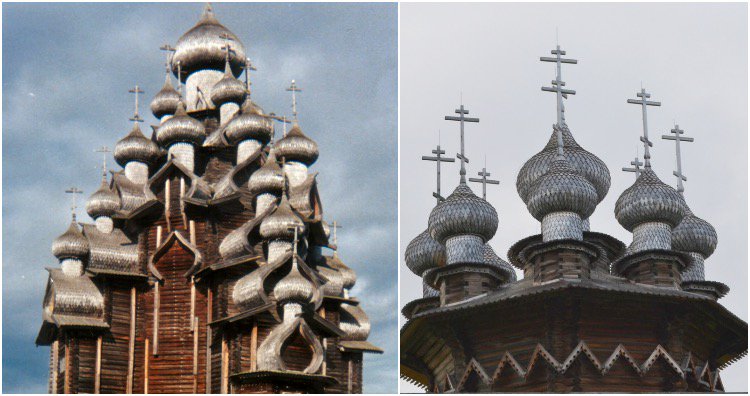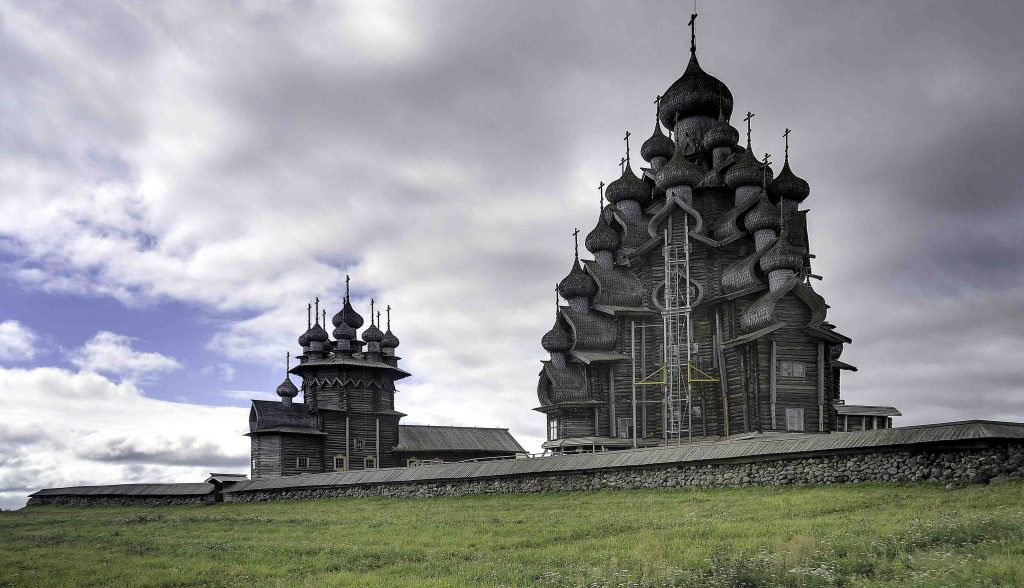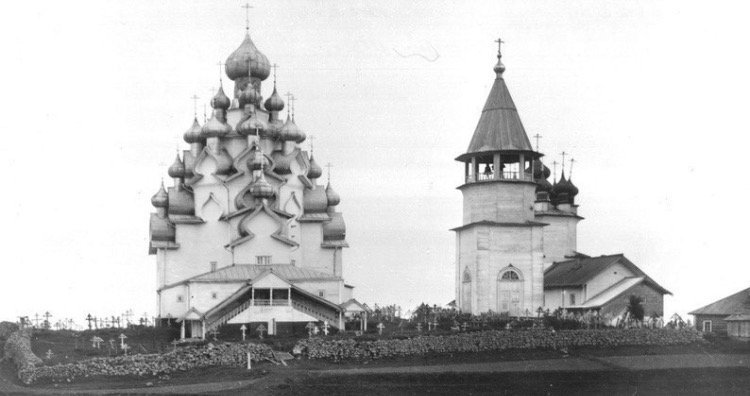300-Year-Old Wooden Church Built Without Nails
300-Year-Old Wooden Church Built Without Nails, Kizhi Pogost (Russian: Кижский Погост) is a historical site dating from the 17th century on Kizhi island. The island is located on Lake Onega in the Republic of Karelia (Medvezhyegorsky District), Russia. The pogost is the area inside a fence which includes two large wooden churches (the 22-dome Transfiguration Church and the 9-dome Intercession Church) and a bell-tower. The pogost is famous for its beauty and longevity, despite that it is built exclusively of wood. In 1990, it was included in the UNESCO list of World Heritage sites[1] and in 1993 listed as a Russian Cultural Heritage site.
When constructing a wooden structure, nails are one of the most important elements. They act as fasteners and hold together the various sections of the structure being built. But one of the tallest wooden churches in the world was built without the use of nails. Kizhi Pogost consists of two wooden churches, both built without the use of nails as was common in ancient, Russian carpentry traditions. These churches represent one of the finest and ornate examples of the great Russian carpentry era.

What makes the Kizhi Pogost unique is that it was constructed without using any nails. No nails were used to hold the different sections of the church together. The basic structure is built of round logs of Scots Pine. The logs are about 30 centimeters in diameter and 3 to 5 meters long. Thousands of logs were brought from the mainland for construction, which was probably quite a logistical challenge at that time. Primarily, a combination of pine, spruce, and aspen wood was used for construction.
The nailless construction can be attributed to the Russian carpentry traditions of that era. The structures were built using interlocking wooden joinery instead of nails. For the domes, hundreds of diamond-shaped wooden tiles were used. These were then layered together to form the bulb-shaped structure. The builders created 22 domes for The Church of the Transfiguration of Our Lord by stacking the wooden tiles together for each dome. This must have been a tedious job at that time! The Church of the Intercession with nine domes is equally impressive.
The Church of the Transfiguration of Our Lord is the most ornate construction of the whole ensemble. Legend has it that the main builder threw his ax into the lake nearby with the words, “there was not and will be not another one to match it.” Seems like his words came true.

Out of all the structures, The Church of the Transfiguration of Our Lord is the most remarkable. The church does not have any heating and is known as a summer church for that reason. No winter services are held at The Church of the Transfiguration of Our Lord. The altar for the church was laid for the first time on June 6, 1714, but the church that is present today was built on the site of the old one that was burned down as a result of a lightning strike. There is no record of the builders who created such a massive and beautiful structure. According to a popular legend, the main builder used the same ax to build the entire structure. When he was done, he threw the ax into the lake nearby uttering “there was not and will be not another one to match it”.
The Church of the Transfiguration of Our Lord comprises of 22 domes and has a height of 37 meters. The 22 domes are of different sizes and shape and they run from the top to the sides (observe the picture above). Some say that this 22-dome was actually a successor of an 18-dome church that used to exist towards the southern side of the Lake Onega. It was built in 1708 and destroyed in 1963 due to fire. This 1708 church is believed to be a forerunner to The Church of the Transfiguration of Our Lord.
Throughout its 300 year history, the historical monuments of Kizhi Pogost have undergone numerous repairs. The walls of the churches were given protective cover in the 19th-century. Also, the domes were covered with metal sheets. But they still never fail to amaze people with their unique beauty.

It’s been 300 years since the monuments were created on the island. They are bound to deteriorate and go through wear and tear over time. In the 19th century, church walls were covered with batten as protective siding boards. They were also painted white. The domes were covered with metal sheets to protect them from rough weather.
Restoration work took place again in the 1940s when the churches were returned to their original appearances. Between 1980 and 1983, a steel framework was incorporated inside the Church of the Transfiguration. Many interior elements like the iconostasis were removed. Despite all the renovations and reconstructions, the church manages to hold a substantial amount of its originality to this day.
Due to its uncertain future and ever more precarious condition, Kizhi Pogost was included on the 1996 World Monuments Watch. In 1996, we partnered with the Norwegian Institute for Cultural Heritage Research and helped local authorities complete some of the most urgent repairs recommended by the International Council on Monuments and Sites and Russian heritage professionals following a survey after it became a UNESCO World Heritage site in 1990. We supplied environmental monitoring equipment for the church and for the pieces of theiconostasis, a screen bearing icons, of the church, which had been dismantled and removed to storage in the 1980s. We also helped improve the storage conditions of these artifacts by equipping a new storeroom on Kizhi Island. In addition, a water cannon fire-fighting system was expanded to cover the entire enclosure. Russian conservation architects and engineers completed a restoration plan, which adheres to the principle of restoring the monument without disassembly. Since then, UNESCO has closely monitored the site.



0 Comments